Main menu
Common skin conditions

NEWS
Join DermNet PRO
Read more
Quick links
Occupational skin disorders in homemakers — extra information
Occupational skin disorders in homemakers
Author: Brian Wu, MD candidate, Keck School of Medicine, Los Angeles, USA. DermNet New Zealand Editor in Chief: Hon A/Prof Amanda Oakley, Dermatologist, Hamilton, New Zealand. Copy editor: Maria McGivern/Gus Mitchell. March 2017.
Introduction
Skin health risks in homemakers
Understanding occupational skin disorders
Occupational skin disorders in homemakers
Assessment
Diagnosis and treatment
Introduction
Millions of women globally are employed as homemakers, housewives or stay-at-home mothers, and are prone to skin disorders as a result of their work in the home.
While increasingly some men are also homemakers, househusbands and stay-at-home fathers, women employed in the home have historically done more wet work (eg, cleaning, washing) than men and have tended to suffer more from a cumulative irritant contact dermatitis of the hands caused by wet work. Housewife’s hand dermatitis (hand eczema) is one of the most frequent reasons for a homemaker to visit a dermatologist.
Why are homemakers particularly at risk of skin disorders?
Homemakers are prone to skin problems because of:
- Wet work (frequent exposure of the hands to water)
- Exposure to chemicals in cleaners, disinfectants, polishes, and other household products
- Failure to wear gloves or use other personal protective equipment
- Widespread lack of education or understanding about the need for skin protection.
Understanding occupational skin disorders
The terms occupational skin disorder or occupational skin disease are used to refer to dermatological conditions that develop or worsen due to the nature of a person’s work. Skin disorders are believed to account for 40–70% of all occupational diseases. Skin disorders occur when the natural defences of the skin are compromised by mechanical, chemical, or biological agents, leaving the skin more vulnerable to infections and the breakdown of the skin barrier.
Occupational skin disorders in homemakers
Skin problems arising in homemakers include:
Housewife’s hand dermatitis
Housewife’s hand dermatitis was so named due to a large number of homemakers who suffer from hand dermatitis due to both irritant contact dermatitis and allergic contact dermatitis. It has been classified into acute ‘wet’ and chronic ‘dry’ types.
- The wet form of housewife’s hand dermatitis involves the back of the hand, the fingers, and the palms. Its signs and symptoms include severe itching, inflammation, and blistering. Common causes of this type of acute contact dermatitis include irritants such as water, detergents, and rubber gloves, and allergens such as nickel, fragrances, and rubber accelerants. This type of dermatitis tends to persist throughout the year.
- The dry form of housewife’s hand dermatitis starts at the tips of the first three fingers. As skin disorder advances, all four fingers of both hands will be affected. Signs and symptoms of chronic hand dermatitis include mild itching, hyperpigmentation, dryness, and nail deformity. The chronic dry form of hand dermatitis tends to be more severe during the winter months.
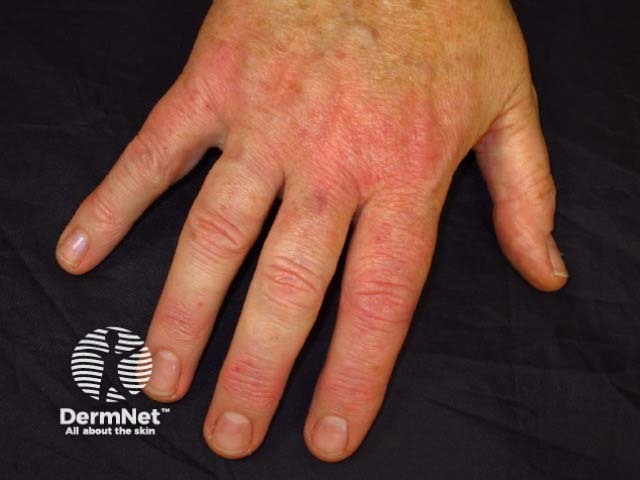
Irritant contact dermatitis
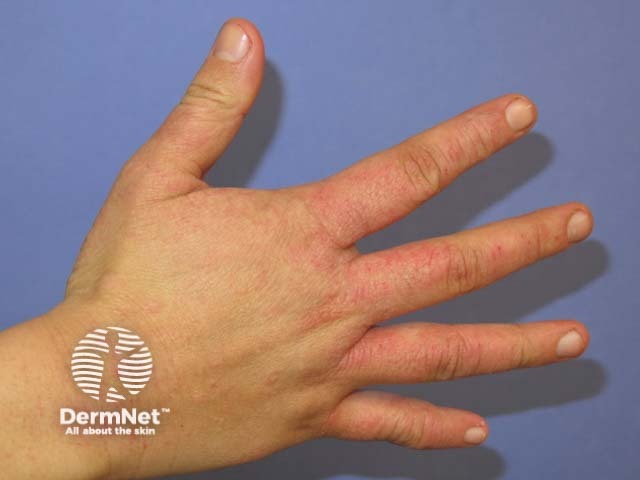
Irritant contact dermatitis
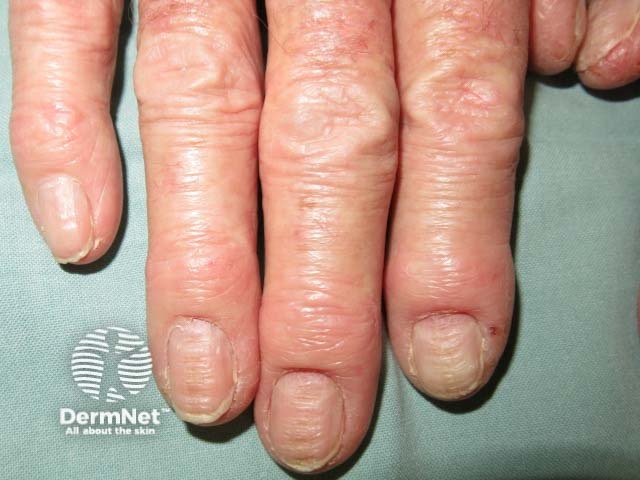
Paronychia with hand dermatitis
Mechanical injuries
Mechanical injuries in homemakers may include minor abrasions and cuts, often associated with scrubbing floors or contact with other rough surfaces.
Infections
Skin infections that can occur in homemakers include the following.
- Secondary bacterial skin infections can complicate dermatitis and wounds.
- Candida yeast infections in the finger webs (intertrigo) can be due to wet work.
- Orf can occur in housewives due to handling pet sheep and goats.
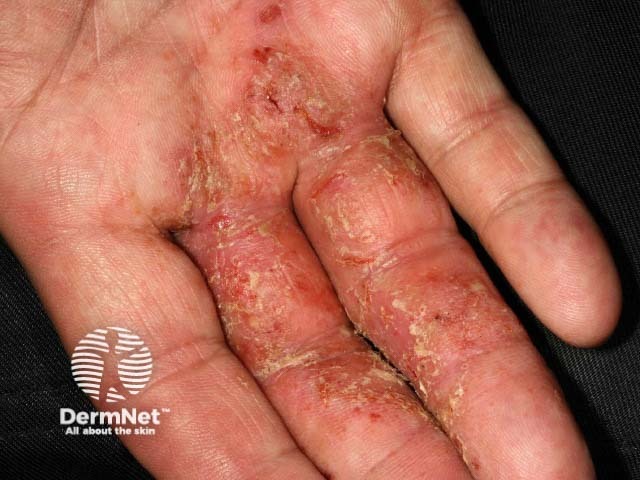
Infected hand dermatitis
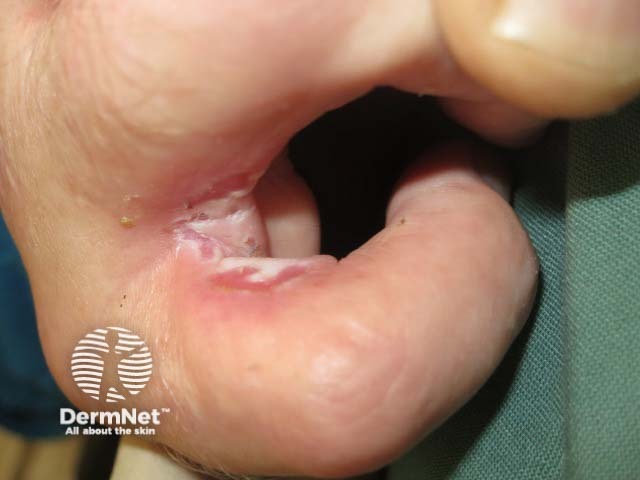
Interdigital candida infection
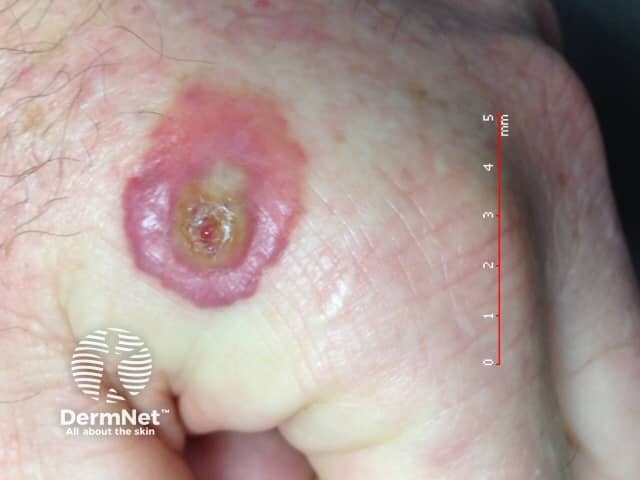
Orf
Assessing the risks
Since the home environment is not a ‘workplace’ in the traditional sense, safety at home is up to the individual homemaker. Factors to consider include:
- The safe handling and storage of various household cleaners
- Checking the directions for the use of various chemicals
- Assessing the chemicals used, possibly switching to less harsh chemical products (or avoiding them, eg, by using microfibre cloths), changing cleaning methods, or mixing or diluting products
- Using appropriate protective gloves during cleaning activities to reduce exposure to water or chemicals.
Personal protective equipment
The most important piece of personal protective equipment for homemakers should be gloves, preferably of a non-latex type to avoid possible sensitisation to latex. If working with volatile/airborne chemicals, protective aprons and masks or goggles should also be considered.
Hand care advice for homemakers
Good hand care can help to prevent hand dermatitis or treat it once it has developed. Tips include:
- Limiting hand-washing to 2–3 times a day
- Using a barrier cream or layering gloves for extra protection
- Sharing housecleaning tasks with other family members or using other means to decrease exposure to water and irritants (eg, using a dishwasher instead of doing dishes by hand)
- Avoiding direct contact with soaps, detergents, or solvents
- Not dying hair at home
- Avoiding the use of rubber gloves.
Diagnosing and treating occupational skin disorders
The diagnosis of an occupational skin disorder should include:
- A careful patient history, particularly relating to specific tasks and contact with irritants and potential allergens
- Consideration of the patient’s other medical conditions, especially those relating to the immune system or atopy
- A clinical examination to note the appearance and location of the dermatitis.
The treatment of an occupational skin disorder can include:
- Education on how to reduce contact with irritants and allergens
- Barrier creams and emollients
- Topical steroids
- Use of gentle non-soap cleansers
- Oral antibiotics for secondary infections
- Oral steroids and immune-modulating drugs for severe or persistent dermatitis.
References
- Nanko H. Treatment of housewives’ hand eczema. Japan Med Assoc J 2002; 128: 772–7. Revised English version
- Environmental Information System (ENVIS) Centre, National Institute of Occupational Health (NIOH), India. Occupational skin diseases. ENVIS-NIOH Newsletter 2010; 5(2): 1–8. Newsletter
- Jordon JW, Dolce FA, Osborne ED. Dermatitis of the hands in housewives: role of soaps in its etiology and methods for its prevention. JAMA 1940; 115: 1001–1006. DOI: 10.1001/jama.1940.02810380031007. Journal Abstract
On DermNet
- Occupational skin disease
- Hand dermatitis
- Contact dermatitis
- Irritant contact dermatitis
- Allergic contact dermatitis
- Pompholyx
- Paronychia
- Personal protective equipment
Other websites
- Irritant contact dermatitis — Medscape
- Hand dermatitis: a review of clinical features, diagnosis, and management — Medscape News, Dermatology Nursing
- Occupational Dermatology Research and Education Centre patient information — Victoria, Australia
